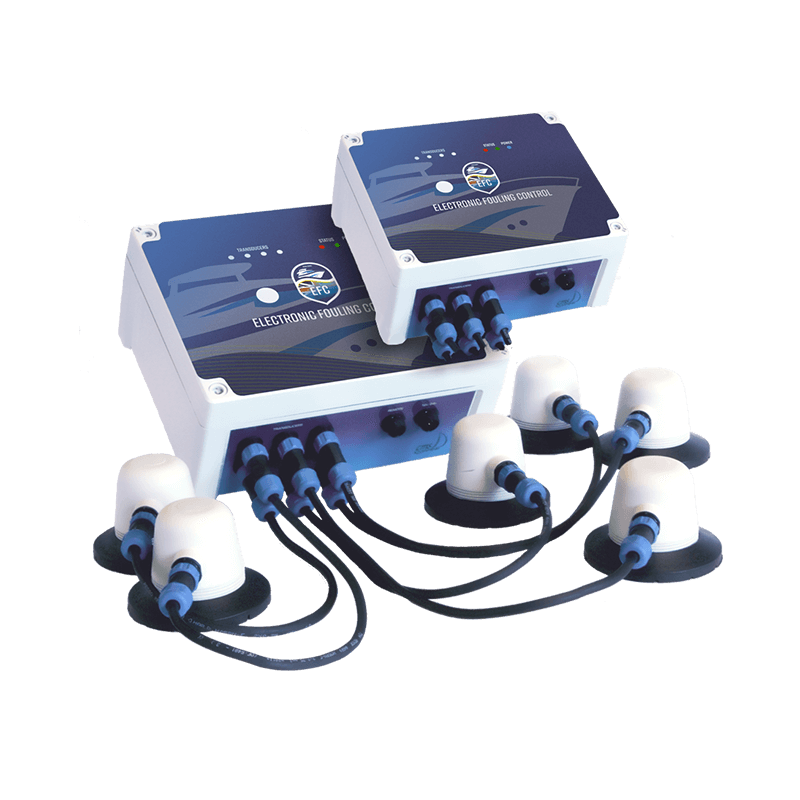As you probably know, antifouling usually takes the form of a biocide (pesticide, usually copper or copper oxide)- containing, specially formulated paint that is applied to the hull of boats to prevent algae, barnacles and other marine growth from attaching to the bottom of your boat. Boat owners use these paint solutions to improve fuel economy by reducing fuel consumption as well as increasing performance and speed of the boat by reducing drag.
There are multiple types of antifoul paint and systems available with different options requiring varying levels of maintenance. In this blog we aim to give you a brief overview of how long these various types of antifouling will last as well as some of the benefits and issues with each.
Traditional antifouling paints
As we outlined in our DIY antifouling blog post, traditional antifouling paint needs to be reapplied annually to provide maximum protection against aquatic life and fouling. The task of removing old antifouling and then applying fresh anti fouling paints is a laborious one and something many boat owners dread.
What affects the lifetime of traditional antifouling paints?
Antifouling type – hard or ablative?
There are two main types of modern paints used for antifouling; hard paints and ablative paints. As a general rule of thumb hard antifouling is to be used on boats that regularly travel in excess of 30 knots, whereas ablative antifouling, used on pleasure boats, yachts and fishing boats will gradually wear away to reveal fresh layers of biocide underneath. However, both types only offer a maximum 12 month protection with hard antifouls requiring cleaning and/or regular vessel use to prevent excessive build up of marine fouling.
Renewal of traditional antifoul paints using labour intensive DIY methods requires the existing paint to be removed either using chemical strippers or wet sanded during spells of dry weather or in a dry dock, before multiple coats of new paint are applied wearing PPE like rubber gloves and a mask. More paint layers are often necessary on the waterline and other high traffic areas such as the rudder for maximum protection. It may be worth noting that, due to the toxic nature the old paint dust and any other waste has to be responsibly disposed of to prevent additional harm to marine life. To find out more about how to antifoul your boat yourself why not take a look at our previous blog.
Boat use
How often you use your boat can impact the lifespan of the antifouling used. Antifoul on boats used regularly will last around 10-12 months, however, if your boat isn’t used for extended periods and is sat on a mooring this will reduce to around 8-10 months before the hull becomes excessively fouled. The movement of the boat through the water will prevent as much marine fouling from attaching and therefore prolong the life of your antifouling.
Storage of your boat when not in use
Does your boat only get launched when you want to use it or does it remain on a wet mooring throughout the season. As you can imagine, the longer your boat is in the water the more quickly the antifouling is likely to need replacing.
Professional antifouling coatings
Soft polymer-based foul release coating system paint is less toxic than the traditional copper-based antifouling paints. The top layers of paint wears away as the boat travels through the water at optimum speed, taking anything attached to it with it. However, as the coating is designed to wear away to reveal fresh antifouling paint underneath, it introduces microplastics into the marine environment.
Antifouling release systems therefore need to be applied as a thicker coat and applied more regularly with increased maintenance during the warmer weather of summer months or if the boat is stood still in water in order to fulfil its role as an antifoul.
Other fibre-based coatings can be professionally applied as films and renewed approximately every five years, however it is essential that the hull be cleaned regularly to prevent biofouling build up throughout its lifespan and so still require regular work as well as being more costly than traditional antifoul paint. These types of antifouling are also much more expensive and require professional application.
Electronic (ultrasonic) antifouling alternatives
It is important that boat owners choose the right antifouling paint for their boat speed, hull type and usage and budget. The regular annual maintenance required on all traditional types of antifoul paint and coatings can be very labour intensive, so a practical boat owner may be looking for an alternative that is much more eco friendly for aquatic organisms and save money at the same time. That’s where ultrasonic fouling systems come in.
Our easy-to-install ultrasonic antifouling systems attach to the hull of the boat with no through-hull drilling and emit high frequency (ultrasonic) waves to deter microorganisms from attaching to the hull. Use of these systems means that you only need to reapply antifoul every three or even up to five years, saving you the annual maintenance of traditional fouling paints.
With reduced use of biocides it makes electronic antifouling a much more eco-friendly way of preventing the build up of marine fouling on your boat hull with less maintenance and a lower annual expenditure, so you can spend more time out enjoying your boat rather than maintaining it.
You can shop our range of ultrasonic antifouling systems for all boat types here, but do get in touch if you have any questions about finding out which ultrasonic antifouling system is right for your vessel – our customer service team would be delighted to help.


